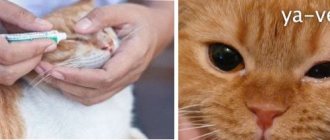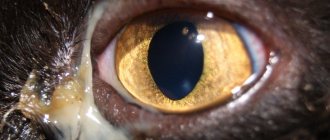In normal condition, cats' ears are a healthy pink color. If you notice brown dirt during your examination, this may indicate an ear infection. What to do if you find dirty ears on your cat?
In the article we told you how to clean your ears and the consequences of lack of hygiene. We figured out in what cases discharge in the ears should not cause concern, and described the causes of infections and inflammation. You will learn what signs indicate the onset of the disease, and what treatment methods exist.
The process of cleaning a cat's ears
Cats are great at keeping their bodies clean, but sometimes they need help reaching hard-to-reach places like their ears. Most pets are not very fond of such interventions, but this is necessary to ensure not only cleanliness, but also health.
In addition to earwax contamination, you can often find an unusual dark-colored coating in your cat's ears. This may indicate pathologies, and in this case it is best to immediately contact a specialist.
Therefore, it is important to understand the possible causes of dirt in cats’ ears.
This is what a healthy cat ear looks like
Causes of dirty ears
Cat ears produce earwax, which cleans and lubricates the ear canals and protects the hearing from dirt and insects. Dust sticks to the earwax, so pets who sometimes walk outside may get their ears more dirty and dirty more often. Those with large ears are also susceptible to heavy contamination. Sulfur is released gradually and even a large accumulation of it does not give the ears a painful appearance: the auricles retain a healthy pink color.
The ears of some pets produce more wax, in which case it is necessary to help the animal maintain hygiene more often. Increased production of ear secretions does not indicate abnormalities or pathologies. However, if sulfur is not removed in a timely manner, inflammatory processes may develop. Also, in exceptional cases, increased sulfur production can be caused by a malfunction of the hormonal system or hypothermia. To exclude such precedents, it is better to show the owner of such ears to a doctor.
In addition, the following reasons explain why dirt accumulates in a cat’s ears.
Elves are susceptible to pollution due to their lack of hair and ear shape
Lack of wool
Hairless cats do not have additional ear protection. In addition, some of them have large ears or, like elves, curved ear tips. In addition to the fact that pollution accumulates faster and more, the body produces sulfur more intensely to ensure protection of the hearing organs from infections. These cats need more careful and frequent ear care.
Allergic reaction
Allergies can be caused by food or change of food, dust, fur of other animals, chemicals, fleas. The manifestation of the reaction on the skin is characterized by increased ear secretion, peeling and change in skin color, and itching. The cat begins to worry and scratch, sometimes trying to penetrate deep into the ear canal; in other cases, animals scratch the skin around the ears until abrasions form, which can cause additional infections.
Atopic dermatitis is a genetic disease and cannot be completely cured. Signs include dry skin and itching, rashes and the formation of ulcers, including in the ears.
Otitis
Inflammation of the middle or inner ear, which may be caused by external trauma, infection in the ear canals, as well as complications due to ear mites or stress. Young animals, individuals with weakened immune systems and a lack of vitamins in the diet are more susceptible to otitis than others. Signs of the disease include inflammation of the skin in the ear canals, hearing loss, severe itching and pain, causing the cat to constantly scratch.
Otitis media must be treated immediately, otherwise the pet may go deaf.
Ear mites under a microscope
Otodectosis
According to statistics, almost three quarters of hearing diseases are caused by otodectosis, otherwise known as ear mites. Microorganisms penetrate the ear canal, feed on blood and skin, multiply and leave waste products, which are oily brown or brown lumps. A cat can become infected with ear mites from other animals and from bacteria brought from the street by a person on their hands or clothing. With otodectosis, the cat's ears are dirty and very itchy, the animal shakes its head, and the discharge has an unpleasant odor.
Normal and pathological brown discharge in a cat's ears
Caring owners know about the need for regular ear hygiene in cats. Careful cleaning of the ear once a week is important for absolutely all pets - regardless of whether they walk outside or not. Indeed, in the warm season, in conditions of high humidity, air or indoor pollution, earwax can become a favorable habitat for pathogenic microorganisms. And its accumulation will lead to the formation of sulfur plug, which will block the ear canal, causing suffering to the animal.
But even if the owner ignores hygiene measures, suspicious brown discharge does not appear in the ears of a cat that is healthy. It’s just that the inner surface of the animal’s ear looks untidy: in places it is covered with ordinary earwax, reminiscent of a viscous yellow-brown coating. By making washing movements with their paws, especially diligent cats partially remove it. Therefore, at different periods of life, the amount of earwax that we see may increase or decrease.
If we are dealing with pathology, then brown discharge from a cat’s ears looks different. They resemble coffee grounds with admixtures of earwax, liquid exudate and dry scales. Pathological secretions accumulate in the external auditory canal, filling the space of the winding ear canal, and may have an unpleasant odor. Spreading along the inner surface of the auricle, they form crusts and a dark thick coating that gradually hardens.
Diagnostic methods
It is not difficult to treat any diseases of the hearing organs, but only at the initial level of the disease.
Therefore, if you suspect a pathology, it is important to visit a veterinarian as soon as possible.
The reason for seeking qualified medical help should be any changes in the animal’s habitual behavior and well-being.
The following signs indicate a possible infection with ear mites or ongoing inflammatory processes:
- scratched skin in and/or around the ear;
- restless behavior accompanied by frequent head shaking and ear scratching;
- thick, lumpy brown plaque in the ears;
- unpleasant odor emanating from plaque;
- feeling of increased humidity in the ear;
- frequency of contamination: often the day after cleaning the situation even worsens;
- unhealthy skin appearance: redness, scabs, sores, rashes;
- the cat often tilts its head to the side;
- lethargy and refusal to eat or, on the contrary, anxious behavior;
- formation of pus and/or appearance of blood;
- swelling of the tissues of the ear canals or ears;
- the cat does not respond to sounds and does not respond to its name;
- lack of coordination;
- discharge of fluids from their ears;
- The cat won't let you touch its ears because it hurts.
View of the ear of an animal infected with otodectosis
How to treat
You can begin to fight the disease only after a visit to a veterinarian, who will prescribe treatment depending on the cause of the pathogen. Cleaning the ears in case of illness without proper treatment can cause serious health consequences.
- Otodectosis
To treat otodectosis, antiparasitic drugs are usually prescribed in the form of injections, drops on the animal’s withers and ear drops. Before instillation of the ears, it is necessary to clean the ears well, otherwise the drug will not reach the source of infection, and the therapeutic effect will be low. Drops in the withers are an excellent way to combat ear mites, especially if the animal does not tolerate cleaning and putting drops in the ears.
In advanced cases of otodectosis, injections are prescribed; the course is on average ten days, during which the procedure must be carried out three times. This method of treatment brings stress and pain to the pet, but some cases of the disease can only be treated in this way. That is why it is important to prevent its development in the early stages of the disease.
If there is more than one animal living in the house, then all of them are treated for otodectosis at once to prevent re-infection and to eliminate the source of the disease.
Constant ear scratching is one of the signs of illness.
- Otitis
Therapy is prescribed depending on the symptoms and usually consists of complex treatment. For infectious otitis, antibiotics are prescribed, antifungal drugs are prescribed for inflammation caused by fungus.
If ear inflammation becomes chronic, surgical intervention is necessary.
Against the background of chronic otitis, the development of neoplasms and hyperplasia of the auditory canal is possible. In this case, timely surgical intervention is necessary.
Due to the wide range of causes and forms of development of the disease, it will not be possible to cure a cat on your own; this will only lead to complications during the course of the disease.
- Allergic reaction
To establish the cause of the allergy and make sure that it was the cause of poor health, it is necessary to take tests for a number of indicators. The doctor will determine what exactly causes rejection in the body.
If the food is not selected in accordance with the needs of the animal’s body, it will certainly cause allergies, which usually manifests itself in the form of itching and skin rashes.
Allergy result
When an allergy is diagnosed, it is recommended to replace food or eliminate foods that cause the reaction, and prescribe certain diets. And to improve well-being, antihistamines and anti-inflammatory drugs are prescribed.
It is worth distinguishing between allergies and intolerances to certain ingredients. For example, vomiting and diarrhea after eating dairy products indicate lactose intolerance. If it occurs frequently, your pet may develop complications such as bacterial and infectious diseases.
How to properly clean a cat's ear
Ears should be checked regularly; each animal has its own rate of ear secretion, so it will have to be removed at different intervals. If your cat has dirty ears, you need to do some preparation and find out how to clean them more effectively. To speed up the process and minimize the animal’s stress, it is better to prepare everything you need in advance: cotton pads, ear cleaning gel. And if your pet offers physical resistance, you will need a towel to immobilize the “patient.” It is good if one of your relatives helps you hold the cat during the procedure.
Do not use alcohol-containing products to clean your ears; they can dry out the skin of the ear canals.
Ear cleaning scheme
- The cleaning product is dripped into the ear (1-2 drops) and left for a couple of minutes, allowing the cat to shake its head and shake out the excess amount of the product;
- Gently bend the ear, as if turning it outward;
- Holding your head, wipe the inside of your ears with a cotton pad. You can use cotton swabs, but it is important to clean in an outward motion, otherwise you may create a wax plug. The stick should not go more than one centimeter into the ear.
Ear cleaning scheme
The procedure for cleaning ears is not the most pleasant for a cat, so it should be done when the animal is calm. Praise your pet throughout the process because it may be difficult for him. At the end of the event, be sure to pet and give a treat to develop a positive association, so that in the future the pet will get used to maintaining hygiene of its hearing organs.
When to contact a veterinarian
It is recommended to visit the veterinarian regularly, performing a preventive examination every six months. This will help to identify diseases in the early stages of development, when it is possible to cure the animal more easily and quickly, without exposing the body to serious danger, surgery or exposure to potent medications.
Here are a number of reasons for an urgent unscheduled visit to the veterinary clinic:
- uncharacteristic odor from the ears;
- a large amount of discharge that appears very quickly;
- refusal of active games;
- decreased appetite;
- general depression;
- lack of shine in the coat, which becomes ragged;
- the appearance of blood and pus;
- constant attempts to scratch in and around the ear.
If you notice dirt in the ears, it is best to take your cat to the doctor.
Preventive measures
Every responsible and good owner should monitor the health of their four-legged friend. His short list of responsibilities also includes ear care. It is necessary to clean them with some regularity (a couple of times a month), using special cosmetics. After the bathing procedure, free the ears from any water and moisture that has entered there. Avoid contact with sick animals, stray cats and dogs.
The most important thing is not to postpone visits to the doctor when the first symptoms of any disease appear. This will help to heal your furry friend in time and save you from serious consequences.
Methods of care and prevention
First of all, you need to regularly check your pet's ears and clean them periodically. At the first sign of a change in plaque in the ears, consult a specialist.
It is best to arrange preventive visits even before signs of pathology appear. It is worth noting that self-medication in cases of hearing loss in most cases leads to a worsening of the situation, even if this does not manifest itself immediately. Inflammatory processes can continue even after the visible symptoms of the disease have disappeared. And prolonged inflammation can lead not only to deafness, but also to death.
To prevent ear mite infestation, you should limit your cat's contact with outdoor animals. This is not easy to do if your pet is used to walking on his own, but try to make sure he distances himself from potential danger.
You can also use prophylactic drops for the withers, which prevent infection with infectious diseases, as well as treating the ear canals with a special composition. Such products are easy to find in a veterinary pharmacy, and they can be used on a kitten or a pregnant cat.
Itching caused by helminths
There are a large number of varieties of parasitic worms that take up residence in a cat’s body. They can be:
- round;
- flat;
- tape.
Usually at the very beginning of infection it is difficult to consider any of its symptoms, but after a while the animal:
- loses appetite and activity;
- becomes restless;
- Constantly licks and itches.
Worms found in the intestines are considered almost harmless.
Difficulties with your pet’s health arise when there are too many helminths and their larvae begin to migrate.
The movement of worms throughout the animal’s body is accompanied by the following symptoms:
- sudden weight loss, increased fatigue, growth retardation in small pets;
- disheveled wool;
- enlarged liver and icteric staining of visible mucous membranes;
- disruption of the digestive system, expressed in constipation, vomiting, diarrhea;
- appearance of cough;
- discharge from the eyes;
- itching in the anus;
- presence of blood in feces;
- premature birth or miscarriage in cats;
- convulsions and paresis of the limbs.
The cat may not notice the presence of parasites in the body in small quantities. However, their increase will not only exhaust the animal, but will also lead to its death. The harm caused to pets by worms can be completely different:
- eating lymph, tissue and blood;
- release of substances that promote intoxication;
- damage to the mucous membranes by suction cups, leading to internal bleeding.
A pet can become infected with helminths in the following ways:
- eating raw meat or fish (especially river fish);
- flea bites;
- contacts with other animals.
To prevent itching, which causes painful scratching, animal owners need to regularly take a preventive course using anthelmintic medications.










